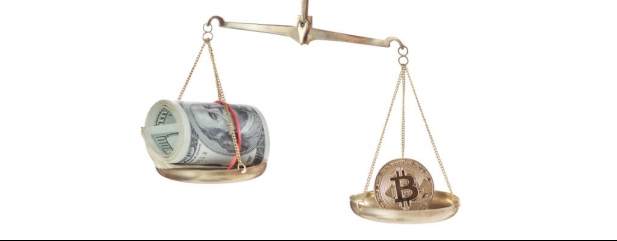Archived article
Please note that tax, investment, pension and ISA rules can change and the information and any views contained in this article may now be inaccurate.
Why bitcoin’s future hangs in the balance

It’s been a painful couple of months for bitcoin investors. The price has fallen from over $65,000 at the beginning of November to around $43,000 at the time of writing. Despite a poor end to the year, bitcoin investors still made a 61% return in 2021.
That’s relatively lacklustre by the cryptocurrency’s own standards, particulary when compared to returns of 1,271% in 2017 and 5,758% in 2013. Longer-term returns are close to incomprehensible. £1,000 invested in bitcoin 10 years ago would be worth around £11 million today.
These figures suggest that anyone jumping on the bitcoin bandwagon now is somewhat late to the party. They might still have a jolly good time for a while, but they aren’t going to be quaffing as much champagne and caviar as the early birds.
In order to generate the same return in the next 10 years as the last decade, the bitcoin price would need to rise to around £380 million per coin, or $520 million, at current exchange rates. Far-fetched doesn’t begin to cover it.
CONSOLATION FOR THOSE WHO MISSED OUT
Those who have sat on the side-lines of the crypto craze can console themselves with the fact that the number of bitcoin believers who have captured the full 10-year return is probably as small as that number is large.
In 2012, bitcoin was little known, and those who did know about it would have just witnessed the hacking of the Mt Gox Bitcoin exchange the year before. Even if they had been brave enough to buy some coins, to enjoy the entire return of £11 million on a £1,000 investment, they would have had to casually sit by and not press the intense panic button as their holding fell by 73% in 2018.

Over 10 years they would also have had to watch their investment double in value 13 times without cashing in any profits. Indeed in 2010, a US computer programmer called Laszlo Hanyecz spent 10,000 bitcoin on two pizzas, in what is widely regarded as the first ever cryptocurrency transaction. Those bitcoins would now be worth over £300 million. This story suggests that even the very early bitcoin adopters had no real inkling of what was to come.
WHAT GOES UP MUST COME DOWN
The risk with an asset that has appreciated so vastly is of course that the price peaks, and the subsequent fall is just as astonishingly sharp as its ascent. One only has to look back a little more than 20 years to the madness of the dotcom boom to recall companies that experienced rocketing share prices, only to become worthless after the bubble burst.
One dotcom darling which managed to weather the storm and still survives today is Nokia. An early investor buying €1,000 of shares in 1991 would have seen their holding swell in value to €398,280 at the peak in 2000, though that would have fallen back to €33,620 today. A more cautionary perspective is that €1,000 invested at the peak would now be worth just €84.
IS BITCOIN BITING THE DUST
As the bitcoin price tumbles, it’s natural to ask whether the cryptocurrency is finally biting the dust. However the performance history of bitcoin suggests a bet in either direction on the cryptocurrency is a risky gamble.
Unlike a stock, bitcoin has no cash flows, no earnings, and no balance sheet, so the price is heavily influenced by sentiment, rather than any fundamentals. A tweet from the Tesla CEO Elon Musk can send the price spiralling in either direction. So while the price is falling rapidly right now, it could easily rebound with no real rhyme or reason for investors to cling on to.
Looking forward, the longer term future of cryptocurrency still hangs in the balance. Goldman Sachs just issued a fairly bullish note on bitcoin, which it sees increasingly usurping gold’s role as a store of value. But it would have to exhibit far less volatility, gain much greater regulatory approval, and achieve a lower carbon footprint, before it made it significant inroads into mainstream professional investment portfolios.
Meanwhile the longer-term adoption of crypto as a means of exchange by businesses and consumers is still highly uncertain, especially given its volatility. Continued scrutiny and pressure from regulators on issues of consumer harm, money laundering, and environmental harm may also dent crypto prospects, as could central banks issuing their own digital currencies.
TRADING THE VOLATILITY
Some investors might not believe bitcoin is a long-term fixture in the financial ecosystem, but be tempted to trade the volatility, and buy the dips. Many of us will have heard or read about traders who have made small fortunes through buying and selling bitcoin. But this activity is closer to gambling than it is investing.
There’s nothing wrong with that in moderation. Plenty of people buy lottery tickets, and place bets on all manner of things from football games to Strictly Come Dancing. But you shouldn’t part with any money that you can’t afford to lose. And if you do get lucky trading crypto, it’s probably best not to splash out on a bottle of fizz before you’ve got the profits firmly in your bank account in pounds, dollars, or euros, because gains can disappear in the blink of an eye.
Important information:
These articles are provided by Shares magazine which is published by AJ Bell Media, a part of AJ Bell. Shares is not written by AJ Bell.
Shares is provided for your general information and use and is not a personal recommendation to invest. It is not intended to be relied upon by you in making or not making any investment decisions. The investments referred to in these articles will not be suitable for all investors. If in doubt please seek appropriate independent financial advice.
Investors acting on the information in these articles do so at their own risk and AJ Bell Media and its staff do not accept liability for losses suffered by investors as a result of their investment decisions.
Issue contents
Danni Hewson
Editor's View
Feature
Great Ideas
News
- THG’s shares take another hit on growth and margin setback
- Why China has bucked a global trend by cutting rates
- Oil hitting $100 could take the FTSE 100 to new record highs
- The trusts trading well below their 10-year average valuation
- Unilever’s food arm could be sold amid shift in strategy
- Wage inflation could hurt many shares
- Billions wiped off the value of construction stocks

 magazine
magazine








